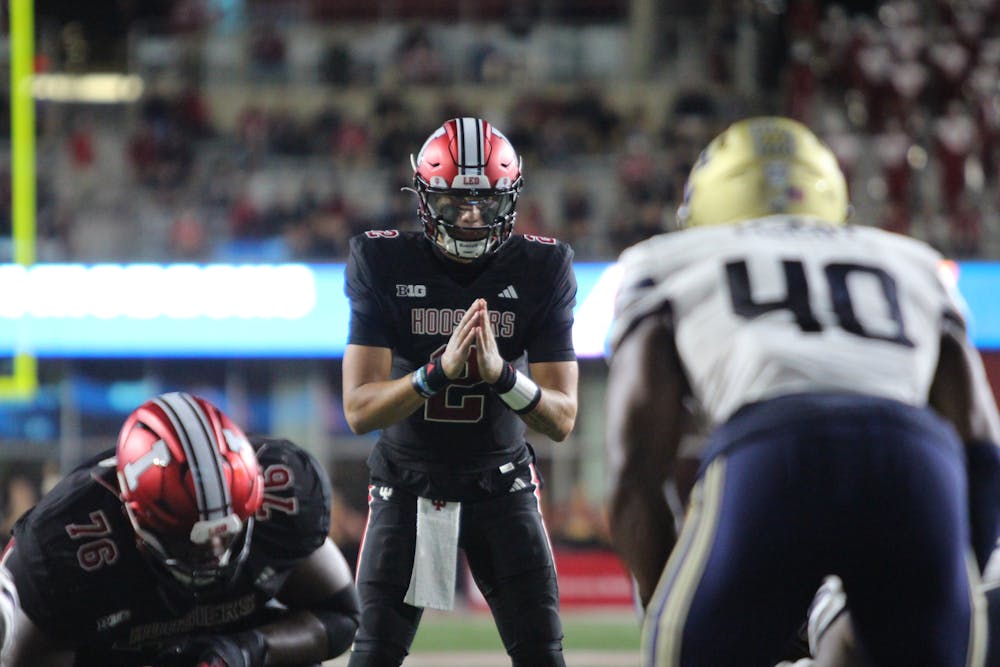Indiana football entered Saturday night’s blackout-themed game against the University of Akron littered with optimism, but by the time the final whistle blew, the only darkness inside Memorial Stadium was the Hoosiers’ seasonal outlook.
A 29-27 victory in four overtimes spearheaded by a missed 32-yard field goal from Akron redshirt junior kicker Dante Jackson to end regulation vaulted the Hoosiers to 2-2 on the season, but survival in a game they entered as 17-point favorites shouldn’t be the goal.
The Zips carried a 1-2 record into Bloomington with their lone win coming by three points over Football Championship Subdivision foe Morgan State University. Their offense ranked third worst in the country in yards per game, while they averaged the second-fewest rushing yards per game.
None of it mattered when the two sides took the field. Akron outgained Indiana, posting 474 yards to the Hoosiers’ 282, and outrushed the home team by a commanding 263 yards to a mere 92. Indiana was dominated on its own field by an opponent who’s won just five games in the previous four seasons.
How does that happen? Indiana head coach Tom Allen said after the game that it was a continuation of an unsatisfactory week of practice during which the Hoosiers had to restart some coaching points on Thursday and illustrated a low degree of focus that left Allen frustrated.
“I just sense the lack of understanding who we were playing and their ability to beat you, which is mind blowing because we don't have any right to think that at this point,” Allen said.
Indiana sixth-year senior linebacker Aaron Casey said afterwards that re-installing certain principles is a normal routine but added there were some things the Hoosiers didn’t practice well during the week.
This created definite frustration on Indiana’s sideline and nearly led to a crushing defeat. Nonetheless, senior defensive back Louis Moore echoed what many thought ahead of Saturday’s game and sent off sirens about just how deeply the Hoosiers overlooked the Zips.
“We took Akron for granted,” Moore said. “I thought we should’ve blown them out.”
On paper, the numbers agreed – but the Hoosiers still needed to execute a full 60 minutes and ended up needing four extra periods just to scrape past. Herein lies the problem.
Prior to the season-opener against Ohio State, Allen made accelerated growth his stated goal. The Hoosiers fell by 20 points to the Buckeyes but responded with a commanding 41-7 win over Indiana State University.
Reaching this goal appeared possible, but a mixed showing in Sept. 16’s 21-14 loss to the University of Louisville slowed the momentum. Allen said Monday that how his team played against the Zips would go a long way toward determining whether they achieved the growth that was possible with playing a top-five team in Week 1.
This performance – being statistically dominated, failing to get one yard at the goal line on three different occasions, allowing Akron to triple their season-long rushing totals and needing a missed short field goal from the backup kicker – doesn't particularly inspire confidence that the Hoosiers took the step they anticipated making.
Indiana will now enter conference play facing a crucial week of preparation. Allen and quarterback Tayven Jackson both said afterwards they’ll be doing a deep evaluation on the little details with an eye towards growth ahead of Sept. 30’s game against Maryland.
Jackson’s showing served as a microcosm for the entire night, as he failed to follow up a strong second half against Louisville. The redshirt freshman signal caller completed only 11-of-26 passes for 190 yards, one touchdown and an interception, with Allen asserting it wasn’t his best effort.
The Hoosiers managed just one offensive touchdown in regulation. Allen declared it was the worst performance from the offensive line, especially running the ball, as Indiana averaged just 2.7 yards per carry, resulting in an outing that fell far short of expectations.
“Not good enough, not even close,” Allen said. “Below the standard. Below what’s acceptable.”
Indiana was booed off the field after running the ball on 3rd and long inside of two minutes to play. At this point, there were less than 10 rows full of students wearing black. The stands took on a checkered look with the number of vacant silver seats.
If Akron’s chance at a game-winning field goal hadn’t sailed wide left, that would’ve been the crowd’s final interaction with the offense on Saturday night.
The game was billed as a blackout, but the overarching theme departing Memorial Stadium is that the Hoosiers remain a long way away from bowl contention – and the dark cloud hovering over the program’s on-field performance appears to have blown back into Bloomington.




